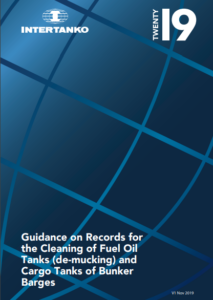Intertanko launched a guide providing shipowners with information concerning proper cleaning of bunker tanks which had in the past stored high sulphur fuel oil, in preparation of the upcoming 2020 sulphur cap, keeping in mind that ships will sail using low sulphur fuel oil.
- Cleaning of waste solid (de-mucking)
The bunker tank is dry as the liquid fuel was removed.
The crew is responsible to collect the solid residues manually and then store for disposal in drums.
Intertanko recommends that this operation has to be conducted in line with the Engine Room operational waste with relevant entry in GRB Part I Category F – Operational waste until disposed to garbage reception facility ashore or burn in ships incinerator.
No entries are being made into the Oil Record Book.
When disposing the garbage either in shore facility or if burned in the incinerator , they have to be categorized as:
- Plastics
- Food wastes
- Domestic Wastes
- Cooking Oil
- Incinerator ashes
- Operational wastes
- Animal Carcass(es)
- Fishing Gear
- e-Waste
- Cleaning of Cargo Tanks of Bunker Barges
This guidance is for recording the cleaning of cargo tanks of bunker barges that were used for HSFO and dedicated in the future for 0.50% Sulphur content fuel.
Such recordings may be also required by ship operators to check if cargo tanks have been cleaned for the use of storing 0.50% or 0.10% Sulphur content fuels.
Cleaning operation of cargo tanks of the bunker barges, transferred manually or by pump, should be recorded in ORB Part II, Code G Cleaning of cargo tanks.
To explore more click on Intertanko’s Guidance herebelow































































